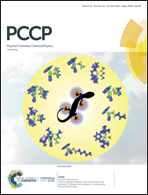The structural basis for Ras activation of PI3Kα lipid kinase†
Abstract
PI3Kα is a principal Ras effector that phosphorylates PIP2 to PIP3 in the PI3K/Akt/mTOR pathway. How Ras activates PI3K has been unclear: is Ras’ role confined to PI3K recruitment to the membrane or does Ras activation also involve allostery? Recently, we determined the mechanism of PI3Kα activation at the atomic level. We showed the vital role and significance of conformational change in PI3Kα activation. Here, by a ‘best-match for hydrogen-bonding pair’ (BMHP) computational protocol and molecular dynamics (MD) simulations, we model the atomic structure of KRas4B in complex with the Ras binding domain (RBD) of PI3Kα, striving to understand the mechanism of PI3Kα activation by Ras. Point mutations T208D, K210E, and K227E disrupt the KRas4B–RBD interface in the models, in line with the experiments. We identify allosteric signaling pathways connecting Ras to RBD in the p110α subunit. However, the observed weak allosteric signals coupled with the detailed mechanism of PI3Kα activation make us conclude that the dominant mechanistic role of Ras is likely to be recruitment and restriction of the PI3Kα population at the membrane. Thus, RTK recruits the PI3Kα to the membrane and activates it by relieving its autoinhibition exerted by the nSH2 domain, leading to exposure of the kinase domain, which permits PIP2 binding. Ras recruitment can shift the PI3Kα ensemble toward a population where the kinase domain surface and the active site position and orientation favor PIP2 insertion. This work helps elucidate Ras-mediated PI3K activation and explores the structural basis for Ras–PI3Kα drug discovery.



 Please wait while we load your content...
Please wait while we load your content...